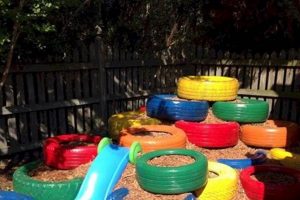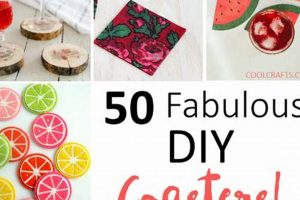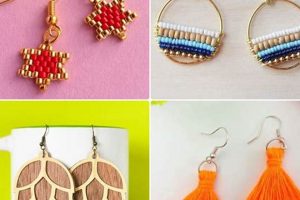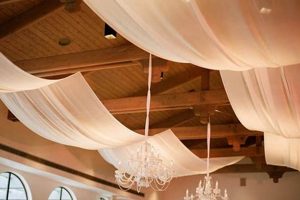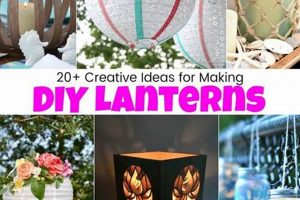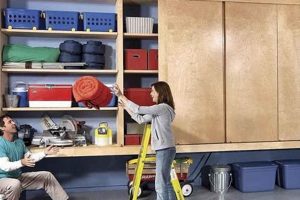Constructions intended to provide sustenance to avian wildlife, created by individuals rather than purchased pre-made, can take myriad forms. These self-assembled structures serve as feeding stations, offering seeds, nuts, and other edibles to attract birds to residential or recreational spaces. A rudimentary example includes an inverted plastic bottle suspended with twine, modified to dispense seeds as they are consumed.
The practice of providing nourishment to wild birds has long been a method of connecting with nature and observing wildlife behavior. Homemade versions of these feeding devices offer a cost-effective and environmentally conscious alternative to commercially available options, promoting resourcefulness and reducing reliance on mass-produced goods. Moreover, they can be tailored to attract specific species and complement the aesthetics of the surrounding environment.
The following sections will explore a range of designs, materials, and construction techniques applicable to the creation of these backyard enhancements, detailing considerations for safety, weather resistance, and ease of maintenance. Examination of different feed types and their impact on avian visitors will also be provided.
Essential Considerations for Homemade Avian Feeding Structures
Successful implementation of self-constructed feeding stations for birds requires careful planning and execution. Attention to detail throughout the building process ensures the structure is both functional and safe for its intended users.
Tip 1: Material Selection: Opt for durable, weather-resistant materials such as untreated wood, recycled plastic, or metal. Avoid chemically treated lumber that could leach harmful substances. Consider the local climate when choosing materials; for example, cedar resists rot in humid environments.
Tip 2: Drainage Implementation: Ensure adequate drainage to prevent seed accumulation and potential mold growth. Drill small holes in the base of the feeding area to allow water to escape. Regularly inspect and clear drainage points to maintain functionality.
Tip 3: Secure Construction: Utilize strong, rust-resistant hardware such as screws or nails designed for outdoor use. Ensure all components are firmly attached to prevent collapse or breakage, particularly during inclement weather or due to animal activity. Reinforce stress points with additional supports.
Tip 4: Predator Deterrence: Position the structure in an open area, away from dense foliage that could provide cover for predators like cats. Consider adding a baffle to the support pole or hanging wire to prevent climbing. Regularly monitor the area for signs of predatory activity.
Tip 5: Accessibility Considerations: Design the feeding area to accommodate a variety of bird sizes and species. Include perches of varying widths and lengths to cater to different foot sizes. Ensure ample space for birds to move around comfortably and minimize competition for food.
Tip 6: Regular Maintenance: Establish a routine cleaning schedule to remove old food, droppings, and debris. Use a mild soap and water solution to scrub surfaces thoroughly. Disinfect periodically to prevent the spread of diseases among birds.
Tip 7: Feed Selection and Storage: Offer a variety of seeds and nuts to attract a wider range of bird species. Store birdseed in airtight containers to prevent spoilage and pest infestations. Research the nutritional needs of local bird populations to provide optimal sustenance.
Adherence to these guidelines will contribute to the creation of a sustainable and beneficial environment for local avian populations. A well-designed and maintained feeding structure provides a valuable resource for birds while offering opportunities for observation and appreciation of the natural world.
The following sections will delve into specific design prototypes and address common challenges encountered during construction and operation.
1. Material Sustainability
The selection of materials for constructing avian feeding structures directly impacts environmental sustainability. The use of non-renewable or unsustainably harvested resources contributes to habitat destruction and resource depletion. Conversely, employing recycled, reclaimed, or sustainably sourced materials reduces the ecological footprint of the project. For instance, utilizing reclaimed wood from demolition projects diverts waste from landfills and minimizes the demand for newly harvested timber. The choice of material, therefore, represents a critical decision point in responsible construction. An analysis of the supply chain and environmental impact of each material is essential to minimizing negative consequences.
The practical implementation of sustainable materials in this context can take several forms. Plastic lumber derived from recycled plastic waste offers a durable and weather-resistant alternative to traditional wood. Bamboo, a rapidly renewable resource, provides a lightweight and strong material suitable for various structural components. Furthermore, incorporating natural elements such as repurposed gourds or pinecones can create aesthetically pleasing and ecologically sound feeders. These materials can be used to build feeders that attract birds to your backyard.
In summary, the integration of material sustainability into the design and construction process represents a fundamental aspect of environmentally conscious avian feeding structures. The practice mitigates environmental damage associated with resource extraction and waste generation. Addressing material selection is crucial and fosters a deeper understanding of the interconnectedness between human actions and ecological well-being. Challenges remain in sourcing affordable and readily available sustainable materials, and further research is needed to evaluate the long-term performance and durability of alternative options.
2. Structural Integrity
Structural integrity is paramount in the design and construction of self-made avian feeding devices. The ability of a feeder to withstand environmental stressors, the weight of its contents, and the activity of birds directly impacts its functionality and longevity. Failure to adequately address structural considerations can result in collapse, spillage of feed, and potential harm to birds or other wildlife. The consequences of inadequate construction range from minor inconveniences to significant safety hazards, highlighting the necessity of a robust design and meticulous execution.
The cause-and-effect relationship between design choices and structural performance is evident in several common scenarios. For example, a feeder constructed from thin, untreated wood may rapidly deteriorate in wet conditions, leading to warping, cracking, and eventual failure. Similarly, a suspension system relying on weak or corroded hardware can fail under the weigh
t of a full feeder, causing it to fall. Conversely, the use of durable materials, such as pressure-treated lumber or heavy-gauge metal, coupled with secure fastening techniques, significantly enhances the feeder’s ability to withstand adverse conditions and maintain its structural integrity. Examples include feeders constructed from repurposed pallets, reinforced with metal brackets at stress points, or those utilizing thick-walled PVC pipe for a weatherproof and structurally sound frame. The careful selection of appropriate materials and assembly methods directly contributes to the overall stability and lifespan of the structure.
In conclusion, structural integrity is not merely an optional consideration, but a fundamental requirement for effective avian feeding structures. A commitment to robust design, durable materials, and meticulous construction practices translates to a safer, more sustainable, and more rewarding experience for both the birds and the individuals who create and maintain these devices. Addressing the challenges of material degradation and structural weakness requires ongoing research and innovation, ultimately leading to improved design and construction standards for this environmentally beneficial practice.
3. Weather Resistance
Weather resistance constitutes a critical factor in the design and longevity of self-made avian feeding structures. The exposure to rain, snow, sun, and fluctuating temperatures necessitates careful selection of materials and construction techniques to prevent degradation and ensure continued functionality. Neglecting weather resistance can lead to premature failure of the structure, rendering it unusable and potentially harmful to birds. The direct impact of environmental elements on materials underscores the importance of proactive measures during the creation process.
The correlation between material choice and weather resistance is exemplified by the use of untreated wood versus treated lumber. Untreated wood, while potentially more aesthetically pleasing, is susceptible to rot and decay when exposed to moisture, significantly shortening the structure’s lifespan. Conversely, pressure-treated lumber or naturally rot-resistant woods like cedar exhibit enhanced durability under similar conditions. Similarly, metal components are prone to corrosion, but utilizing galvanized or stainless steel hardware mitigates this issue. Proper sealing and painting also provide a protective barrier against moisture penetration. Example: A basic structure made from cardboard degrades rapidly when exposed to rain, while those made from recycled plastic bottles or ceramic pots perform much better. Consider drainage holes to prevent water accumulation and regular maintenance, such as reapplying sealant to wood or rust inhibitor to metal components, helps extend the service life of a self-made feeder. This also ensures that it continues to serve it’s initial intent and not become something harmfull to the users.
In conclusion, weather resistance is not an optional feature but an integral aspect of constructing effective and sustainable avian feeding structures. Informed material selection, appropriate construction techniques, and consistent maintenance are essential for mitigating the detrimental effects of environmental exposure. A robust understanding of these principles enhances the usefulness of homemade feeders, providing a reliable source of sustenance for birds while minimizing waste and environmental impact. Continuing this research into new design options can add to a growing arsenal of information for bird lovers and environmentalists alike.
4. Accessibility
The attribute of accessibility, concerning constructions intended to provide sustenance to avian wildlife, encompasses design features that enable diverse bird species, irrespective of size, mobility, or behavioral traits, to utilize the feeding apparatus. A poorly designed structure, lacking accessibility considerations, may inadvertently favor certain species while excluding others, thereby undermining the intended objective of supporting a broad spectrum of avian life. This situation generates a direct correlation between design parameters and the breadth of avian engagement. For instance, a feeder with exceedingly small entry points might exclude larger species, while one lacking perches may prove unusable for birds that prefer to perch while feeding.
The implementation of accessibility principles manifests practically through a variety of design modifications. Adjustable perch configurations cater to varied bird sizes and leg strengths. Placement of multiple feeding ports, distanced adequately, reduces interspecies competition. Physical barriers, strategically incorporated, can discourage dominant species from monopolizing the feed supply, thereby enhancing opportunities for more timid birds. Platform feeders, positioned close to natural cover, offer secure access for ground-feeding birds. These considerations extend beyond physical dimensions to include visual cues. The strategic use of contrasting colors, for example, can aid birds with limited visual acuity in locating the feeding area. Placement must also consider avian escape routes, so birds don’t become easy prey.
In conclusion, accessibility stands as a critical, not merely supplementary, element in the successful implementation of avian feeding stations. The intentional integration of design features that accommodate a diverse array of bird species promotes ecological balance and ensures equitable resource distribution. Overcoming the challenge of attracting a broad avian population requires ongoing observation, adaptive design modifications, and a commitment to creating feeding environments that cater to the needs of all potential beneficiaries. Further study of avian feeding preferences, behavioral dynamics, and environmental adaptations is essential to inform ongoing design improvements.
5. Pest Mitigation
Effective pest mitigation is an integral consideration in the design and maintenance of self-constructed avian feeding structures. Uncontrolled pest activity can deplete food resources intended for birds, transmit diseases, and damage the structure itself. Therefore, implementing preventative measures and control strategies is crucial for ensuring the long-term viability and benefit of the feeding station.
- Elevated Design and Placement
Elevating structures and selecting appropriate locations are fundamental preventative measures. Raising feeding areas above ground level restricts access for rodents and certain insect species. Placement away from dense vegetation minimizes harborage for pests. A minimum height of four feet is generally recommended. Structures placed near buildings or trees provide easier access for squirrels and other climbing pests.
- Physical Barriers and Baffles
The deployment of physical barriers serves as a direct deterrent to climbing pests. Baffles, constructed from metal or plastic, impede access to the feeding area. Cone-shaped baffles are particularly effective when installed on poles supporting the feeder. Smooth, non-grip surfaces on supporting structures also hinder climbing attempts. Maintenance involves regular inspection and adjustments to ensure continued ef
fectiveness. - Appropriate Feed Selection and Storage
The type of feed offered influences the likelihood of attracting undesirable species. Seed mixes containing large quantities of filler seeds (e.g., milo, wheat) are less attractive to desirable birds and more appealing to pests. Storing birdseed in airtight, pest-proof containers is essential for preventing infestations. Spilled seed should be cleaned up promptly to eliminate a food source for pests.
- Regular Cleaning and Maintenance
Regular cleaning is critical for minimizing pest attraction and disease transmission. Removing old food, droppings, and debris reduces potential breeding sites for insects and rodents. Disinfecting surfaces with appropriate cleaning agents further limits pest populations. Diluted bleach solutions can be effective but should be used cautiously to avoid harming birds. Consistent maintenance prolongs the lifespan of the structure and reduces the need for more intensive pest control measures.
Integrating these facets of pest mitigation into the design and upkeep of homemade avian feeding structures results in a more sustainable and beneficial environment for intended avian visitors. A proactive approach to pest control minimizes resource competition and disease transmission, enhancing the overall effectiveness of the feeding station. While these measures can significantly reduce pest activity, ongoing monitoring and adaptive strategies are essential for addressing evolving challenges.
6. Avian Safety
Avian safety represents a primary consideration in the conception, construction, and maintenance of self-assembled avian feeding devices. The utilization of inappropriate materials, flawed designs, or inadequate maintenance practices can pose significant threats to bird health and well-being. Prioritizing safety measures is crucial for ensuring that these structures serve as a beneficial resource rather than a potential hazard.
- Sharp Edges and Protrusions
The presence of sharp edges or protrusions on a constructed feeding device presents a tangible risk of physical injury to birds. These features, often arising from imprecise cutting or assembly, can cause lacerations or puncture wounds, increasing the vulnerability of birds to infection or predation. Mitigation requires thorough inspection and careful refinement of the structure, eliminating all potential sources of injury. Rounded edges and smooth surfaces are preferable. Example: Rough cut edges on wooden components should be sanded smooth. A bird feeder that leads to injury will drive away users quickly.
- Entrapment Hazards
Design flaws can inadvertently create entrapment hazards, posing a significant threat to birds. Structures with narrow openings or enclosed spaces may trap birds, leading to starvation, dehydration, or increased susceptibility to predation. Thorough evaluation of the design is essential to identify and eliminate potential entrapment points. Opening sizes should be large enough to prevent birds from becoming lodged within the structure. Example: Inverted bottles used as seed dispensers require careful modification to prevent birds from becoming trapped inside.
- Toxic Materials
The utilization of toxic materials in the construction of feeding devices presents a direct threat to avian health. Chemically treated lumber, paints containing lead, and certain types of adhesives can release harmful substances that are ingested or absorbed by birds. Adherence to non-toxic materials is imperative to prevent poisoning and associated health complications. Untreated wood, water-based paints, and food-grade adhesives are preferable alternatives. Research local ordinance to see what’s acceptable.
- Hygiene and Disease Transmission
Poor hygiene practices in the maintenance of feeding devices facilitate the transmission of diseases among birds. Accumulation of old food, droppings, and moisture provides a breeding ground for bacteria, fungi, and parasites. Regular cleaning and disinfection are essential to minimize the risk of disease outbreaks. The frequency of cleaning should be adjusted based on environmental conditions and bird activity. Use diluted bleach or other appropriate disinfectants.
In summation, avian safety constitutes an indispensable element in the responsible creation and maintenance of avian feeding structures. Mitigation of physical hazards, avoidance of toxic materials, and adherence to stringent hygiene protocols are paramount for ensuring the well-being of the birds that utilize these resources. A commitment to these principles transforms a potentially hazardous endeavor into a beneficial contribution to avian conservation. The aforementioned components and factors are all vital to safe, easy to use, and effective feeders.
7. Feed Variety
The diversification of feed offered through self-constructed avian feeding structures directly influences the range of species attracted and the nutritional benefits conferred. The intentional selection and provision of a spectrum of feed types constitutes a fundamental aspect of responsible and effective feeder design.
- Seed Type and Feeder Design
Different avian species exhibit preferences for particular seed types. Sunflower seeds, for instance, attract a wide array of birds, while thistle seed is favored by finches. The design of the feeding structure must accommodate these preferences. Tube feeders with small ports are well-suited for thistle seed, while platform feeders accommodate larger seeds and provide space for ground-feeding species. Incorrect pairing of feed type and feeder design reduces utilization and increases waste.
- Suet and Energy Requirements
Suet, a high-fat food source, provides essential energy, particularly during colder months and periods of migration. Suet feeders, typically wire cages or mesh bags, prevent birds from carrying off large pieces. Incorporating suet into a feeding strategy expands the nutritional offerings and attracts insectivorous species. Variations include suet cakes mixed with seeds, nuts, or dried fruit. Locations can also be adapted to allow a variety of birds the chance to access these energy-rich resources.
- Nuts and Protein Sources
Nuts, such as peanuts and walnuts, offer a rich source of protein and healthy fats. Shelled nuts or nut mixes can be offered in platform feeders or specialized nut feeders. Providing nut-based options attracts jays, woodpeckers, and other species that benefit from high-protein diets. Ensuring nuts are free from salt and other additives is essential to avian health. Care should be taken to ensure that nut pieces are small enough to prevent choking.
- Live Food and Insectivores
Attracting insectivorous birds requires the provision of live food sources, such as mealworms or insect-based suet cakes. These options cater to the dietary needs of species that primarily consume insects. Live mealworms can be offered in shallow dishes or specialized feeders designed to prevent escape. Integrating live food sources enhances the ecological value of the feeding station and supports a wider range of avian species.
The careful consideration of feed variety, in conjunction with appropriate feeder design, optimizes the effectiveness of self-constr
ucted avian feeding structures. This multifaceted approach not only attracts a wider range of species but also ensures that their nutritional needs are adequately met. This allows these unique spaces to thrive and create a beautiful habitat where the birds can feed.
Frequently Asked Questions
The following section addresses common inquiries regarding the design, construction, and maintenance of self-made avian feeding structures. The information provided aims to clarify misconceptions and offer practical guidance for maximizing the effectiveness and safety of these devices.
Question 1: What materials are unsuitable for constructing these feeding structures?
Chemically treated lumber poses a potential risk to avian health due to the leaching of toxic substances. Similarly, painted surfaces containing lead or other heavy metals can contaminate food sources and harm birds. Materials prone to rapid degradation, such as cardboard or thin plastics, lack the durability required for outdoor use.
Question 2: How can one prevent squirrels from dominating these feeding areas?
Physical barriers, such as baffles installed on the support poles, effectively impede squirrel access. Locating the feeder away from overhanging branches or structures minimizes jumping points. Providing a dedicated squirrel feeder containing less desirable food sources may divert their attention.
Question 3: What are the recommended cleaning protocols for these devices?
Regular cleaning with a mild soap and water solution removes accumulated food debris and droppings. A diluted bleach solution (1 part bleach to 9 parts water) can be used for disinfection, followed by thorough rinsing. The frequency of cleaning should be adjusted based on weather conditions and the level of bird activity.
Question 4: How does the selection of feed impact the species attracted?
Different bird species exhibit preferences for specific seed types. Sunflower seeds attract a wide variety of birds, while thistle seed is favored by finches. Offering a diverse selection of seeds and nuts increases the likelihood of attracting a broader range of avian visitors. Commercial birdseed mixes often contain filler seeds that are less appealing to desirable species.
Question 5: What design features enhance avian safety?
Sharp edges or protrusions should be eliminated to prevent physical injury. Enclosed spaces should be avoided to minimize the risk of entrapment. Perches should be adequately spaced to prevent overcrowding and competition. A roof or overhang can provide protection from the elements.
Question 6: How can one minimize the spread of avian diseases at these stations?
Regular cleaning and disinfection are crucial for preventing the transmission of diseases. Avoiding overcrowding by providing multiple feeding ports reduces the potential for direct contact. Removing sick or dead birds promptly minimizes the risk of further spread. Consideration should be given to seasonal closure if an outbreak occurs within the local bird population.
In summary, diligent attention to material selection, structural design, maintenance protocols, and feed selection is essential for creating safe, effective, and sustainable avian feeding structures. A proactive approach to problem-solving ensures that these devices serve as a beneficial resource for local bird populations.
The subsequent section will explore advanced design concepts and address regional variations in avian feeding practices.
DIY Bird Feeder Ideas
This exposition has detailed critical considerations for the construction and maintenance of diy bird feeder ideas. Emphasis has been placed on material selection, structural integrity, weather resistance, accessibility for diverse avian species, pest mitigation strategies, avian safety protocols, and the impact of varied feed offerings. The integration of these facets directly influences the success and sustainability of backyard avian support systems.
Responsible implementation of self-made feeding stations contributes to avian well-being and fosters a deeper connection with the natural world. Continued adherence to best practices, coupled with ongoing innovation in design and materials, ensures the sustained provision of vital resources for bird populations while promoting environmental stewardship. The future of these efforts depends on a collective commitment to informed action and a dedication to the welfare of avian ecosystems.


